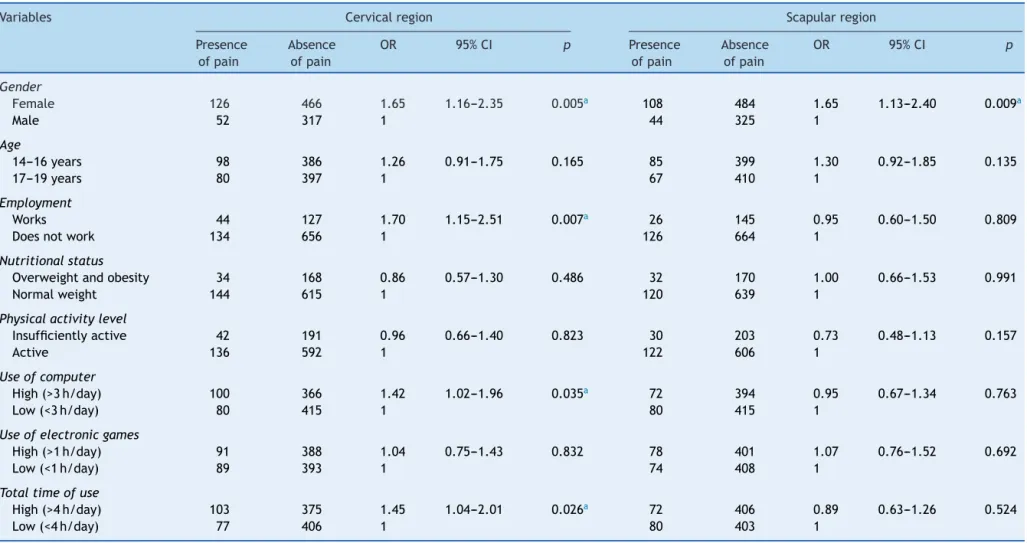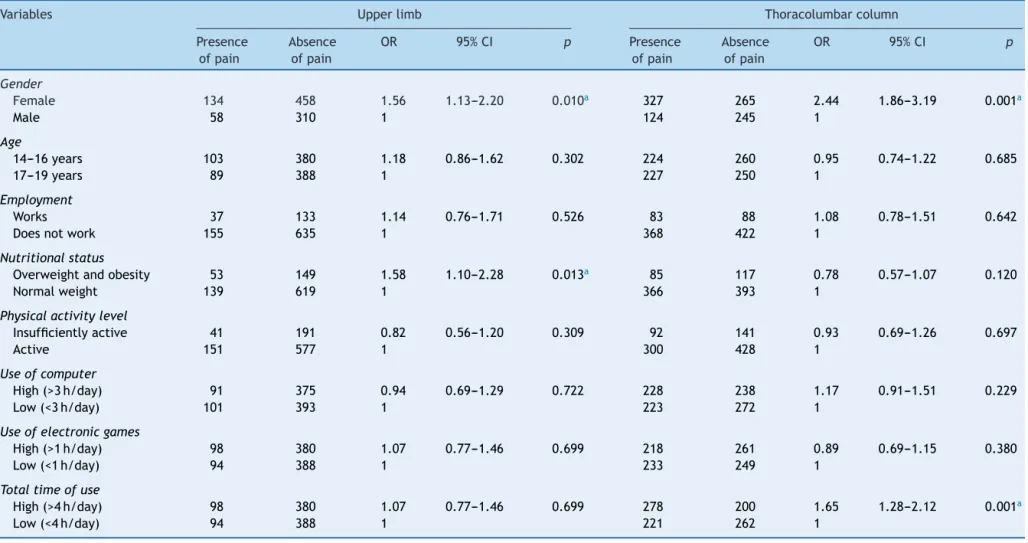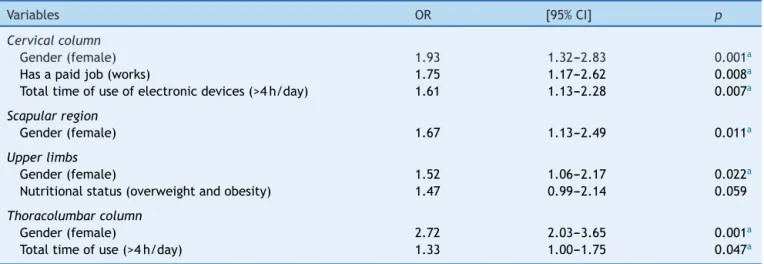www.jped.com.br
ORIGINAL
ARTICLE
Prevalence
of
musculoskeletal
pain
in
adolescents
and
association
with
computer
and
videogame
use
夽
Georgia
Rodrigues
Reis
Silva
a,
Ana
Carolina
Rodarti
Pitangui
a,b,
Michele
Katherine
Andrade
Xavier
a,
Marco
Aurélio
Valois
Correia-Júnior
b,
Rodrigo
Cappato
De
Araújo
a,b,c,∗aMaster’sDegreePrograminAdolescentHealth,UniversidadedePernambuco(UPE),Recife,PE,Brazil bDepartmentofPhysicalTherapy,UniversidadedePernambuco(UPE),Petrolina,PE,Brazil
cPostgraduatePrograminPhysicalEducation,UniversidadedePernambuco(UPE),Recife,PE,Brazil
Received24February2015;accepted30June2015 Availableonline28December2015
KEYWORDS
Musculoskeletalpain; Adolescent;
Computersystems; Videogames
Abstract
Objective: Thisstudyinvestigatedthepresenceofmusculoskeletalsymptomsinhighschool adolescentsfrompublicschoolsanditsassociationwithelectronicdeviceuse.
Methods: Thesampleconsistedof961boysandgirlsaged14---19yearswhoanswereda ques-tionnaire regarding the use of computersand electronic games, and questions about pain symptomsandphysical activity.Furthermore, anthropometricassessments ofallvolunteers wereperformed.Thechi-squaredtestandamultiplelogisticregressionmodelwereusedfor theinferentialanalysis.
Results: Thepresenceofmusculoskeletalpainsymptomswasreportedby 65.1%ofthe ado-lescents,beingmore prevalentinthethoracolumbar spine(46.9%), followedby paininthe upperlimbs,representing20%ofcomplaints.Themeantimeofuseforcomputersand elec-tronicgameswas1.720and583minutesperweek,respectively.Theexcessiveuseofelectronic devices wasdemonstrated tobe arisk factor for cervicalandlumbarpain. Female gender wasassociatedwiththepresenceofpainindifferentbodyparts.Presenceofapaidjobwas associatedwithcervicalpain.
Conclusion: Ahighprevalenceofmusculoskeletalpaininadolescents,aswellasanincreased amountoftimeusingdigitaldeviceswasobserved.However,itwasonlypossibletoobservean associationbetweentheincreaseduseofthesedevicesandthepresenceofcervicalandlow backpain.
©2015SociedadeBrasileiradePediatria.PublishedbyElsevierEditoraLtda.Allrightsreserved.
夽 Pleasecitethisarticle as:SilvaGR, Pitangui AC,Xavier MK,Correia-JúniorMA,Araújo RC. Prevalence ofmusculoskeletalpain in
adolescentsandassociationwithcomputerandvideogameuse.JPediatr(RioJ).2016;92:188---96.
∗Correspondingauthor.
E-mail:rodrigo.cappato@upe.br(R.C.DeAraújo).
http://dx.doi.org/10.1016/j.jped.2015.06.006
Musculoskeletalpaininadolescents 189
PALAVRAS-CHAVE
Dor
musculoesquelética; Adolescente; Sistemasde computac¸ão; Jogosdevídeo
Prevalênciadedormusculoesqueléticaemadolescenteseassociac¸ãocomuso decomputadorejogoseletrônicos
Resumo
Objetivo: Esteestudoinvestigouapresenc¸adesintomasmusculoesqueléticosemadolescentes estudantesdoensino médioemescolaspúblicasesuaassociac¸ãocomousodedispositivos eletrônicos.
Método: Aamostrafoi compostapor961meninosemeninascomidade entre14e19 anos que responderam questionário sobre o uso de computadores, jogos eletrônicos e questões relacionadasasintomasdolorososeatividadefísica.Alémdisso, todososvoluntáriosforam submetidosàavaliac¸ãoantropométrica.Paraanáliseinferencialforamutilizadosostestesde qui-quadradoemodelomúltiploderegressãologística.
Resultados: Apresenc¸ade sintomasdedormusculoesqueléticafoireportada por65.1%dos adolescentes, sendo mais prevalente na coluna toracolombar (46,9%), seguida por dornos membrossuperiores,representando20%dasqueixas.Otempomédiodeusodecomputador ejogoseletrônicosfoi1720e583minutosporsemana,respectivamente.Ousoexcessivodos dispositivoseletrônicosmostrou-secomofatorderiscoparadorcervicalelombar.Osexo fem-ininoapresentouassociac¸ãocomapresenc¸adedoremdiferentespartesdocorpo.Aatividade profissionalesteveassociadacomadorcervical.
Conclusão: Observou-se altaprevalênciadedormusculoesqueléticanosadolescentese ele-vadotempo deusodosdispositivoseletrônicos.Entretanto,foipossívelobservarsomente a associac¸ãodousoexcessivodessesdispositivoseapresenc¸adedorcervicalelombar. ©2015SociedadeBrasileiradePediatria.PublicadoporElsevierEditoraLtda.Todososdireitos reservados.
Introduction
Theuseofelectronicdeviceshas,inrecentyears,become an important part in the lives of adolescents, who reg-ularly use computers to carry out academic and leisure activities.1,2Otherresourcesusedbythispopulationinclude
the different types of electronic games, which, just like
computers,haveattractedanexaggeratedinterest,causing
childrenandadolescentstospendhoursbeingentertained
by such technologies, often interfering with their social
relationships.3,4
The excessiveuseofthesedeviceshasbeen associated
withseveralhealth problems,suchasobesity,headaches,
anxiety,stress,sleepdisorders,musculoskeletal pain,and
decreasedphysicalactivitylevels.1,2,5,6
Musculoskeletal symptomsarea majorcauseof acute,
chronic, and recurrent pain in children and adolescents,
significantly affecting the psychosocial status and
consid-eredapublichealthproblem.7---11Theirprevalenceinrecent
studies with adolescents has ranged between 19.5% and
56%.2,8---11
Studies have shown that prolonged periods in a static
positionmayresultinspinalcolumnpainandincreasethe
risk of developing complaintsin other body partss.12---15 A
study carriedout withFinnish adolescents suggested that
musculoskeletal symptomsthat causemoderate tosevere
painarecommonamongcomputerusers.2
Theassociationbetweencomputeruseandthepresence
of musculoskeletal pain in adolescents was not
demon-stratedin astudyconducted inBrazilin 2004.12 However,
studies performed in developed countries have
demon-strated anassociation between timeofcomputeruse and
painful symptoms in the lower limbs and cervical spinal
columnofadolescents.13,16,17Therefore,itcanbeobserved
that the time factor, added to the technological
devel-opment and socioeconomic level of a region, may have
influencedtheseresults.
Considering the recent technological and economic
growthobservedinBrazilandthatconcomitanttothisfact,
therehasbeenanincreaseinaccesstothesetechnologies,
it is believed that today’s adolescents are more exposed
totheseresources. Additionally,in 2012,theState
Secre-tariatofEducation(SecretariaEstadualdeEducac¸ão---SEE)
ofPernambuco,using astrategy considered tobe
innova-tive,distributedlaptopstoallhighschoolstudents,thereby
increasingaccesstothistypeoftechnology.Theaimofthis
study was to determine the prevalence of
musculoskele-talpainin adolescentsanditsassociationwiththe useof
electronicdevices.
Methods
This was an epidemiological, correlational, and cross-sectionalstudy,whichwasapprovedbytheResearchEthics CommitteeoftheUniversidadedePernambucounder pro-tocolNo.CAAE13598313.5.0000.5207.
Thesampleselectionprocedurefollowedasequenceof stepsaimingtoobtainarepresentativesampleregardingthe distributionofstudentsaccordingtogeographicregionand schoolsize. Initially,the numberof schools that hadhigh schoolclasseswasobserved.Then,takingintoaccountthe geographicalandorganizationaldistribution,schoolswere dividedintoeachoftheRegionalEducationOffices.Finally, schoolsweredividedintothreecategories:small(upto200 students),medium-sized(201---499students),andlarge(500 ormorestudents).18,19
Inthesecondstage,theclustersamplingwasperformed
intwosteps,consideringtheschoolandtheclassassampling
units.Inthefirststep,schoolproportionalitywasconsidered
bysize; inthe second step,theproportionality of classes
wasconsidered.19Therefore,theauthorsfoundaminimum
numberof23schoolsand96classes, whichrepresent20%
ofpublicschoolsinRecifeandatotalof954adolescents.
Inclusioncriteriaincludedattendingoneoftheselected
schoolsandagebetween14and19years.Exclusioncriteria
comprised the inadequate completion of the
question-naireorrefusaltoundergoanthropometricmeasurements.
Pregnantwomenandstudentswhohadmusculoskeletalpain
orinjuriesduetoinfectious,genetic,ortraumaticdisorders
wereexcludedfromthestudy.
Datawerecollectedthroughaconstructedandadapted
questionnaire aimedto assesssociodemographic variables
(age,gender,schoolyear,presenceofapaidjob,and
fam-ilyincome),dataontheuseofcomputerandvideo games
(ageofonsetof use,weekly frequency,andtimeofuse),
presenceofmusculoskeletalpain(locationanduseofpain
medications),andphysicalactivitylevel.
Aself-administeredquestionnaire wasusedtoevaluate
theuseofelectronicdevicesandpainfulsymptoms,which
included aspects of the musculoskeletal system painful
symptoms,bodydiagramfor symptom location,and
ques-tionsrelatedtotheuseofcomputerandvideogames.This
toolhasexcellentinterdayreliability(Kappa>0.72).11,12
To evaluate the pain symptoms, the adolescents were
askedtoindicateinthebodycharttheregionswherethey
hadexperiencedpaininthelastsixmonths.Asforthepain
symptoms,theadolescentsansweredthequestionsrelated
totheuseofelectronicdevices,alwaysconsideringthesix
months prior tothe day of data collection. Timeperiods
greaterthan4h/dayfortheuseofallelectronicequipment,
3h/dayfor computers, and1h/dayfor video gameswere
consideredexcessive.Thesecutoffpointsweredetermined
bythemedianvaluefoundintheassessedsample.
The level of physical activity was assessed based on
theanswerstotheInternationalPhysicalActivity
Question-naire(IPAQ)---ShortForm,20 andvolunteerswereclassified
asactiveorinsufficientlyactive.The anthropometricdata
wererecordedusingaG-THECportableelectronicscalewith
150kgcapacity(CamryElectronic,USA)andaWCSportable
stadiometer(CardiomedComérciodeEquipamentos
Médi-cosLTDA,Brazil).Thesedatawereusedtocalculatebody
mass index (BMI) and toperform overweight and obesity
classification.21
Data analysis was performed using SPSS software(IBM
Corp.Released2011.IBMSPSSStatisticsfor Windows,
Ver-sion20.0; USA). Bivariatelogistic regression modelswere
constructed to test the isolated association between the
dependentvariableandeachindependentvariable,aswell
astoanalyzethevariablesinthemodel,toexplorethe
possi-bleconfoundingfactorsandidentifytheneedforstatistical
adjustmentofanalysis.Multiplelogisticregressionwasused
throughtheestimateofoddsratioand95%confidence
inter-vals(95%CI)toexpressthedegreeofassociationbetween
theindependentvariablesandthepresenceofpain.
Forthefinalmultiplemodel,theselectedvariableswere
those whose p-value was <0.20. In all tests, a p-value
<0.05 wasconsidered statistically significant. Considering
thesamplingdesign usedin thestudy(clustersampling in
twostages),itwasdecidedtoperforminferentialstatistics
usingthe‘‘complex samplingmode’’ ofSPSStoapplythe
correctionofestimatesforthedesigneffect.
Results
Intotal,1020adolescentswereincludedinthestudy. How-ever, 59 individuals were excluded due to errors when completing the questionnaire. The final sample consisted of 961 adolescents. The sociodemographic and anthropo-metriccharacteristics, nutritionalstatus, physical activity level,presenceofapaidjob,anddatarelatedtotheuseof electronicdevicesaredescribedinTable1.
The presence of pain symptoms was reported by 626
(65.1%)adolescents.Theanatomicalregionwiththe
high-est prevalence of paincomplaints wasthethoracolumbar
spine(n=451;46.9%[95%CI:43.7---50.1%]),followedbythe
upper limbs (n=192; 20% [95% CI: 17.5---22.7%]), cervical
spine (n=178; 18.5% [95% CI: 16.1---21.1%]), and scapular
region(n=152;15.8%[95%CI:13.5---18.3%]).
It was observed that 199 adolescents (31.8% [95% CI:
28.2---35.6%]) reported that using the computer was the
triggering factor for at least onesymptom. Other factors
citedastriggerswerephysicalexercisein128(20.5%[95%
CI:17.6---23.8%])andtheuseofelectronicgamesin18
ado-lescents(2.9%[95%CI:1.7---4.5%]).
Anotherassessedaspectwastheinfluenceofpain
symp-toms when performing activities of daily living, with the
adolescentsreporting thatat least oneof the pain
symp-toms interfered with or hindered the accomplishment of
study tasks (143; 22.8% [95% CI: 19.7---26.3%]), sleeping
(115; 18.4% [95% CI: 15.4%---21.6%]), and playing sports
(110;17.6%[95%CI:14.7---20.8%]).Additionally,186(29.7%
[95% CI: 26.2---33.5%]) adolescentssaid that the presence
ofpainmadethemmorenervous. Finally,201(32.1%[95%
CI:28.5---35.9%])adolescentsreportedthattheymade
spo-radic use of analgesics, while another 70 (11.1% [95% CI:
8.8---13.9%])reportedthattheyfrequentlyusedthesedrugs.
The resultsof the bivariateregression analysisshowed
that female gender was associated with musculoskeletal
paininallassessedanatomicalregions.Anassociationwas
observedbetweenthepresenceofcervicalpainandhaving
apaidjobaswellashighamount oftimeusingelectronic
devices (Table 2). High amount of time using electronic
devices wasassociated with pain symptomsin the
thora-columbarregionandexcessweightwasassociatedwithpain
symptomsintheupperlimbs(Table3).
The multivariate model results for the pain symptoms
in thefourassessedareasareshown inTable4.The
vari-ablegenderremainedassociatedinthefinalmodel ofthe
Musculoskeletalpaininadolescents 191
Table1 Sociodemographic,anthropometriccharacteristics,nutritionalstatus,physicalactivitylevel,andoccupationof ado-lescentsfrompublicschoolsinRecife,stratifiedbygender.
Variables Male Female Total
Numberofvolunteers 369 592 961
Age(years) 16.61±1.35 16.40±1.23 16.5±1.3
Schooling
1styear 146 218 364
2ndyear 106 167 273
3rdyear 112 212 324
Bodymass(kg) 64.68±13.60 56.15±10.79 59.45±12.64
Height(m) 1.71±0.07 1.60±0.06 1.64±0.08
Familyincome
1---2minimumwages 235 461 696
Morethan2minimumwages 134 131 265
Nutritionalstatus
Normalweight 300 459 759
Overweightandobesity 75 127 202
Physicalactivitylevel
Active 282 446 728
Insufficientlyactive 88 145 233
Hasapaidjob
Yes 65 106 171
No 310 480 790
Computeruse
Yes 332 521 853
No 37 71 108
Hasacomputerathome
Yes 281 434 715
No 88 158 246
Ageatthestartofuse(years) 11.3±2.8 11.3±2.4 11.3±2.6
Frequencyofuse(days/week) 5.5±2.1 5.5±2.1 5.5±2.1
Weeklytimeofuse(minutes) 1703.4±1357.4 1731.7±1596.5 1720.8±1508.5
Useofelectronicgames
Yes 297 310 607
No 72 284 354
Frequencyofuse(days/week) 3.25±2.55 1.82±2.30 2.37±2.50
Weeklytimeofuse(minutes) 949.77±1143.76 354.94±675.39 583.34±930.62 Totaltimeofuseofelectronicdevices(minutes) 2653.21±2125.98 2086.67±1955.69 2304.40±2040.40
Dichotomouscategoricalvariablesareshownasabsolutefrequencyvalues. Continuousvariablesareshownasmeanandstandarddeviation.
use remained associated with pain in the cervical and thoracolumbar regions. Presence of a paid job remained associatedwiththepresenceofpaininthecervicalregion and the nutritional statusremained in the final model of upperlimbpain,althoughwithoutasignificantassociation.
Discussion
A high prevalence of musculoskeletal pain was observed amongtheadolescents,higherthanthatshowninprevious studiesinBrazil11,12andinothercountries.2,22Thisevidence
alone reinforces the importance of such investigation of
factorsassociatedwiththisproblemandthus, itbecomes
essentialtoprovidehealth assessmentandcomprehensive
healthcare.
As for symptom location, the region with the
high-estprevalence of pain complaintswasthe thoracolumbar
spine(46.9%). Recentstudies withBrazilian23 andChinese
students8showedaprevalenceratecloseto32%forlowback
pain.Althoughthesefindingswerelower,theystillseemto
corroboratethepresentresults,asthisstudyalsoincluded
symptomsrelatedtothethoracicspine,whichmayexplain
thisdifference.Thesecondmostprevalentpainwasinthe
upperlimbs,followedbythecervicalspine.Thesefindings
corroboratepreviousstudies,2,3whichreportedprevalence
ofpaininthecervicalandshoulderregionsinapproximately
Silva
GR
et
al.
Table2 Sociodemographicvariables,physicalactivitylevel,nutritionalstatus,anduseofelectronicdevicesandtheirassociationwithcomplaintsofpaininthecervicaland scapularregions.
Variables Cervicalregion Scapularregion
Presence ofpain
Absence ofpain
OR 95%CI p Presence
ofpain
Absence ofpain
OR 95%CI p
Gender
Female 126 466 1.65 1.16---2.35 0.005a 108 484 1.65 1.13---2.40 0.009a
Male 52 317 1 44 325 1
Age
14---16years 98 386 1.26 0.91---1.75 0.165 85 399 1.30 0.92---1.85 0.135
17---19years 80 397 1 67 410 1
Employment
Works 44 127 1.70 1.15---2.51 0.007a 26 145 0.95 0.60---1.50 0.809
Doesnotwork 134 656 1 126 664 1
Nutritionalstatus
Overweightandobesity 34 168 0.86 0.57---1.30 0.486 32 170 1.00 0.66---1.53 0.991
Normalweight 144 615 1 120 639 1
Physicalactivitylevel
Insufficientlyactive 42 191 0.96 0.66---1.40 0.823 30 203 0.73 0.48---1.13 0.157
Active 136 592 1 122 606 1
Useofcomputer
High(>3h/day) 100 366 1.42 1.02---1.96 0.035a 72 394 0.95 0.67---1.34 0.763
Low(<3h/day) 80 415 1 80 415 1
Useofelectronicgames
High(>1h/day) 91 388 1.04 0.75---1.43 0.832 78 401 1.07 0.76---1.52 0.692
Low(<1h/day) 89 393 1 74 408 1
Totaltimeofuse
High(>4h/day) 103 375 1.45 1.04---2.01 0.026a 72 406 0.89 0.63---1.26 0.524
Low(<4h/day) 77 406 1 80 403 1
Musculoskeletal
pain
in
adolescents
193
Table3 Sociodemographic variables, levelof physical activity, nutritional status, and use of electronicdevices and their association with complaints of pain in the thoracolumbarregionandupperlimbs.
Variables Upperlimb Thoracolumbarcolumn
Presence ofpain
Absence ofpain
OR 95%CI p Presence
ofpain
Absence ofpain
OR 95%CI p
Gender
Female 134 458 1.56 1.13---2.20 0.010a 327 265 2.44 1.86---3.19 0.001a
Male 58 310 1 124 245 1
Age
14---16years 103 380 1.18 0.86---1.62 0.302 224 260 0.95 0.74---1.22 0.685
17---19years 89 388 1 227 250 1
Employment
Works 37 133 1.14 0.76---1.71 0.526 83 88 1.08 0.78---1.51 0.642
Doesnotwork 155 635 1 368 422 1
Nutritionalstatus
Overweightandobesity 53 149 1.58 1.10---2.28 0.013a 85 117 0.78 0.57---1.07 0.120
Normalweight 139 619 1 366 393 1
Physicalactivitylevel
Insufficientlyactive 41 191 0.82 0.56---1.20 0.309 92 141 0.93 0.69---1.26 0.697
Active 151 577 1 300 428 1
Useofcomputer
High(>3h/day) 91 375 0.94 0.69---1.29 0.722 228 238 1.17 0.91---1.51 0.229
Low(<3h/day) 101 393 1 223 272 1
Useofelectronicgames
High(>1h/day) 98 380 1.07 0.77---1.46 0.699 218 261 0.89 0.69---1.15 0.380
Low(<1h/day) 94 388 1 233 249 1
Totaltimeofuse
High(>4h/day) 98 380 1.07 0.77---1.46 0.699 278 200 1.65 1.28---2.12 0.001a
Low(<4h/day) 94 388 1 221 262 1
Table4 Multipleassociationmodelofmusculoskeletalpaininhighschooladolescents.
Variables OR [95%CI] p
Cervicalcolumn
Gender(female) 1.93 1.32---2.83 0.001a
Hasapaidjob(works) 1.75 1.17---2.62 0.008a
Totaltimeofuseofelectronicdevices(>4h/day) 1.61 1.13---2.28 0.007a Scapularregion
Gender(female) 1.67 1.13---2.49 0.011a Upperlimbs
Gender(female) 1.52 1.06---2.17 0.022a
Nutritionalstatus(overweightandobesity) 1.47 0.99---2.14 0.059
Thoracolumbarcolumn
Gender(female) 2.72 2.03---3.65 0.001a
Totaltimeofuse(>4h/day) 1.33 1.00---1.75 0.047a
OR,oddsratio;95%CI,95%confidenceinterval. aStatisticallysignificant---p<0.05.
Regarding the use of electronic devices, several stud-ieshave shown increasedcomputer use,asdemonstrated in this study, with prevalence ranging between 74% and 99%ofadolescents.1,11,14Thisresultmaybeassociatedwith
the implemented government program, which distributed
theequipmenttoallhighschoolstudentsandcontributed
toincreasing access to this technology, which was
previ-ouslyonlyassociatedwithfamiliesofhighersocioeconomic
level.4,5,24 According toprevious studies,the totalweekly
timespentbyadolescentsusingcomputersrangedfrom80
to840min.2,4,5,24---27Nonetheless,thepresentstudyshowed
timespentatthecomputercloseto1720minutesperweek,
raisingquestionsabout that time,asseveralstudies have
emphasized the association of several health complaints
withexcessiveuseofsuchdevices.2,28
Regarding the use of electronic games, Milde-Busch
etal.1reportedalowfrequency(27%)amongadolescents,
whichdiffersfromtheresultsofthisstudy.Thishigher
fre-quencyis probablydue to thefact that electronic games
havebecomeincreasingly popular,representingoneofthe
mostimportantleisureactivitiesforadolescents,regardless
of age and socioeconomic strata.25,26 This finding is
rein-forced by the data found in relation to the weekly time
of use, which averagedclose to583min, higherthan the
390mindescribedinpreviousstudies.4,5,12
Regarding the analysis of factors associated with pain
complaints,it wasobservedthatthe femalegender,total
time of electronic device use, nutritional status, and
presence of a paid job remained in the final statistical
models.
Female gender wasassociated withpain complaintsin
allanatomicalregionsandwasconsideredariskfactor.The
presenceofpaincomplaintsindifferentbodyregionsbythe
adolescentswasalsodemonstratedinastudycarriedoutin
Finland,inwhichgirlsreportedpaininallanatomicalsites
and,consequently,moredisruptiontodailylife.2
The genderquestion canbeexplainedby thefactthat
womencomplainmorethanmen,oftenreportingmore
rele-vanthealthinformationduetosocialandeducationalissues,
aswellasthepresenceofhormonalchangesduringpuberty.9
Thesefindingshavebeendemonstratedbyotherstudiesin
theliterature.16,23Costiganetal.29reportedthatgirlsshow
lowerlevels ofphysical activity andincreased timespent
insedentarybehaviorsassociatedwithhormonalvariations,
which negatively contribute to several health indicators,
includingmusculoskeletalpain.
Another sociodemographic factor associated with pain
symptoms, specifically cervical pain, was presence of
a paid job. Although studies conducted with
adoles-cents about pain symptoms have similar characteristics
to those of the present study, regarding the assessment
ofschoolchildren2,14,22,23 andtheprevalenceof adolescent
females,2,16 many of these studies2,22,23 disregarded data
relatedtohavingapaidjobandemployment.Zapataetal.12
reportedthatlessthan1%oftheassessedadolescentshad
ajob.
Inthe present study,approximately18%of the
adoles-centsreportedhavingajob,differingfromtheresultsfound
in the literature.13 This finding can be explained by
dif-ferencesinsocioeconomicstatusof theassessedsamples,
aspreviousstudies2,12,14,22,23reportedassessingmiddle-class
adolescents or students from private schools, whereas in
thisstudy themajority ofassessed studentshadlow
fam-ilyincome.Possiblyduetothissituation,thissamplehadto
worktohelpwithfamilyexpenses,whichcancontributeto
greaterphysicalandmentalstress.
Theuse ofelectronic deviceswasonlyassociatedwith
paincomplaintsinthespinalcolumn.Inthisrespect,itwas
observed thattheisolateduse of computersor electronic
games showed no association with pain complaints;
how-ever,whenassessingthecombineduseofthesedevices,it
became clearthat theelevated total timeofuse is
char-acterizedasariskfactor for thepresenceofcervical and
thoracolumbarpain.
Corroborating these results, Hakala et al.2 also found
that computer use is associated with cervical pain;
how-ever, witha mean timeof useof 2h daily. Another study
showed that the longerthe time of screen exposure, the
greaterthechancesofdevelopingspinalcolumnpain.22
Musculoskeletalpaininadolescents 195
electronicgamesandcomputers,differingfromtheresults
found in this study.This differenceis possiblydue to the
characteristicsrelatedtothetimeofthestudy,giventhat
theaccessandscreentimereportedbyZapataetal.,12ten
yearsago,waslowerthanthatfoundinthepresentstudy
andinothers.2,22
Inadditiontothepresenceofpainanditslocation,the
assessmentofitsintensityisalsorecommended.However,
the study by Hakala etal.2 is the only one that assessed
theassociationbetweencomputeruseandthelocationand
intensityofpainsymptomsinthespinalcolumnof
adoles-cents.Althoughtheauthorsreportedthatexcessiveuseof
thesedevicesisrelatedtomoderate andsevereintensity,
theypointoutthatthesedatashouldbeanalyzedwith
cau-tion,consideringthatthestudycross-sectionaldesigndoes
notallowforinferenceofcausality,aswellasthefactthata
self-reportevaluationmayshowrecallbias.Theauthorsalso
showedthatthesubjectivenatureofpainassessment can
generateincorrectinformationand/oroverestimationofthe
responses.Corroboratingthisinformation,Rothaugetal.30
described thatpainassessment withbinaryresponses is a
morepracticalmethodforpainassessmentwhencompared
totheuseofnumericalscales,withthebinarymethodbeing
preferredbymostpatients.
Consideringthisinformation, itwasdecidednottouse
painintensityassessmentinthisstudy,asallthesepossible
limitations,inadditiontothesix-monthrecall,could
gener-ateasignificantbias,thusaffectingtheresults.Theauthors
considered thepossibilitythat, insix months,the
adoles-centscouldhave hadmorethan oneepisodeof pain,and
theseepisodescouldhavehadvariationsintheirduration;
therefore,the reportofpainintensity wouldbecomplex,
subjective,andsubjecttoconsiderablevariation.
Although no association was verified between the use
of electronic devices and other pain complaints, it was
observedthat31.8%oftheadolescentsreportedthatusing
a computerwas a triggering factor of at least one
symp-tom.Anotherimportantaspectreferstothereportthatthe
presenceofpainsymptomsinterferedwithmanydaily
activ-ities,suchasperformingtasks,sleep,andpracticingsports,
aswellasbeingresponsibleforself-medicationina
signifi-cantnumberofsubjects,whichcancausehealthproblems
orevenmasksymptomsofmoreimportantdiseases.
Thisstudyhassomesample-relatedlimitations,asthese
werepublicschoolstudents and,thereforeits
generaliza-tion to other populations is not possible. The data were
obtainedfromstudents’self-reportsand,thus,recall bias
maybepossible; itis importanttoexercisecaution when
interpretingthesedata.However,theseresultsarerelevant,
astheysuggestthattechnologicaldevelopment,which
soci-etyisfacing,canhavesignificanteffects,requiringconstant
monitoringofhealthindicatorsandassociatedfactors.
Finally,theresultsshowedahighprevalenceof
muscu-loskeletal pain and the high amount of time spent using
electronic devices. However, the increased use of these
devicesonlyshowedanassociationwithpaininthecervical
andthoracolumbarregions.
Conflicts
of
interest
Theauthorsdeclarenoconflictsofinterest.
References
1.Milde-Busch A, Von Kries R, Thomas S, Heinrich S, Straube A, Radon K. The association between use of electronic media and prevalence of headache in adolescents: results from a population-based cross-sectional study. BMC Neurol. 2010;10:12.
2.Hakala PT, Saarni LA, Punamäki RL, Wallenius MA, Nygård CH,RimpeläAH.Musculoskeletalsymptomsandcomputeruse amongFinnishadolescents---painintensityandinconvenience toeverydaylife:across-sectionalstudy.BMCMusculoskelet Dis-ord.2012;13:41.
3.Desai RA, Krishnan-Sarin S, Cavallo D, Potenza MN. Video-gaming among high school students: health correlates, gender differences, and problematic gaming. Pediatrics. 2010;126:e1414---24.
4.GentileD.Pathologicalvideo-gameuseamongyouthages8to 18.PsycholSci.2009;20:594---602.
5.Dumith SC, Hallal PC, Menezes AM, Araújo CL. Seden-tary behavior in adolescents: the 11-year follow-up of the 1993 Pelotas (Brazil) birth cohort study.Cad Saude Publica. 2010;26:1928---36.
6.Dumith SC, Domingues MR, Gigante DP, Hallal PC, Menezes AM, Kohl HW. Prevalence and correlates of physical activity among adolescentsfromSouthernBrazil. RevSaudePublica. 2010;44:457---67.
7.Roth-IsiqkeitA,ThyenU,StovenH,SchwarzbergerJ,Schmucker P.Pain among childrenand adolescents: restrictionsindaily livingandtriggeringfactors.Pediatrics.2005;115:e152---62.
8.ShanZ,DengG,LiJ,LiY,ZhangY,ZhaoQ.Correlationalanalysis ofneck/shoulderpainandlowbackpainwiththeuseof digi-talproducts,physicalactivityandpsychologicalstatusamong adolescentsinShanghai.PLOSONE.2013;8:e78109.
9.YaoW,LuoC,AiF,ChenQ.Riskfactorsfornonspecificlow-back pain inChinese adolescents acase---control study.Pain Med. 2012;13:658---64.
10.Perry MC, Straker LM, Oddy WH, O’Sullivan PB, Smith AJ. Spinalipainandnutritioninadolescents---anexploratory cross-sectionalstudy.BMCMusculoskeletDisord.2010;11:138.
11.JaniniSN,Dória-FilhoU,DamianiD,SilvaCA.Musculoskeletal paininobeseadolescents.JPediat(RioJ).2011;87:329---35.
12.ZapataAL,MoraesAJ,LeoneC,Doria-FilhoU,SilvaCA.Pain andmusculoskeletalpainsyndromesrelatedtocomputerand videogameuseinadolescents.EurJPediatr.2006;165:408---14.
13.SmithL, LouwQ, CrousL, Grimmer-SomersK. Prevalenceof neckpainandheadaches:impactofcomputeruseandother associativefactors.Cephalalgia.2009;29:250---7.
14.DeVittaA,MartinezMG,PizaNT,SimeãoSF,FerreiraNP. Preva-lenceoflowerbackpainandassociatedfactorsinstudents.Cad SaudePublica.2011;27:1520---8.
15.Kelly G, Dockrell S, Galvin R. Computer use at school: its effect on posture in discomfort in schoolchildren. Work. 2009;32:321---8.
16.BoströmM,Dellve L, ThoméeS,HagbergM. Riskfactors for generally reduced productivity --- a prospective cohortstudy ofyoungadultswithneckorupper-extremitymusculoskeletal symptoms.ScandJWorkEnvironHealth.2008;34:120---32.
17.JacobsK,HudakS,McGiffertJ.Computer-relatedpostureand musculoskeletaldiscomfort inmiddle schoolstudents.Work. 2009;32:275---83.
18.Tenório MC, Barros MV, Tassitano RM, Bezerra J, Tenório JM, Hallal PC. Physical activity and sedentary behavior among adolescenthigh schoolstudents.Rev BrasEpidemiol. 2010;13:105---17.
20.Craig CL, Marshall AL, Sjöström M, Bauman AE, Booth ML, AinsworthBE,et al.International PhysicalActivity Question-naire:12-countryreliabilityandvalidity.MedSciSportsExerc. 2003;35:1381---95.
21.Cole TJ, Bellizzi MC, Flegal KM, Dietz WH. Establishing a standarddefinitionforchildoverweightandobesityworldwide: internationalsurvey.BMJ.2000;320:1240---3.
22.TorsheimT,ErikssonL,SchnohrCW,HansenF,BjarnasonT, Väli-maaR.Screen-basedactivitiesandphysicalcomplaintsamong adolescents from the Nordic countries. BMC Public Health. 2010;10:324.
23.LemosAT,SantosFR,MoreiraRB,MachadoDT,BragaFC,Gaya AC.Lowbackpainandassociatedfactorsinchildrenand adoles-centsinaprivateschoolinSouthernBrazil.CadSaudePublica. 2013;29:2177---85.
24.Silva KS, Nahas MV, Hoefelmann LP, Lopes AS, Oliveira ES. Associations between physical activity, body mass index, and sedentarybehaviors inadolescents. RevBrasEpidemiol. 2008;11:159---68.
25.Burke A, Peper E. Cumulative trauma disorderrisk for chil-drenusingcomputerproducts:resultsofapilotinvestigation
with a student convenience sample. Public Health Rep. 2002;117:350---7.
26.Altenburg TM,Singh AS, vanMechelenW, BrugJ, Chinapaw MJ.Directionoftheassociationbetweenbodyfatnessand self-reportedscreentimeinDutchadolescents.IntJBehavNutr PhysAct.2012;24(9):4.
27.Strasburger VC, Jordan AB, Donnerstein E. Health effects of media on children and adolescents. Pediatrics. 2010;125:756---67.
28.PrimackBA, CarrollMV,McNamara M,KlemML,King B,Rich M, et al. Role of video games in improving health-related outcomes: a systematic review. Am J Prev Med. 2012;42: 630---8.
29.CostiganSA,BarnettL,PlotnikoffRC, LubansDR.Thehealth indicators associated with screen-based sedentary behavior amongadolescentgirls:asystematicreview.JAdolescHealth. 2013;52:382---92.


